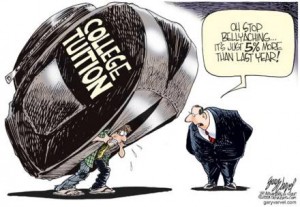 Anti-tax organizations and a prevailing attitude among resident and politicians in many states that public dollars should not be used for higher education have led to states paying less of the costs for education at public universities.
Anti-tax organizations and a prevailing attitude among resident and politicians in many states that public dollars should not be used for higher education have led to states paying less of the costs for education at public universities.
That means the cost of going to college has shifted more and more to the student themselves.
In an article on the issue, the Chronicle of Higher Education reported that college education in the United States has reached a “tipping point.” In about half of the states in the nation, students already pay a larger share of the costs of private education than the school does.
Just 10 years ago, students paid only one-third of the cost for a public education, with tax dollars and other funds from the public schools picking up the tab.
It’s important for business students to know the situation as they prepare to attend college. Most studies and surveys still show a high value to getting a college degree. But as they cost shifts more to students, they need to research the many low-interest loans, scholarships and federal grants available to help the finance their education.
The shift had been gradual, but accelerated during and after the recession. State politicians have cut taxes for public schools. In real dollars, they give more than they did, but the rate has not kept up with the rate of inflation, according to the Chronicle of Higher Education.
A total of $81.3 billion was spent by all the states on higher education in 2012. Adjusted for inflation, that is the lowest amount spent per student since 1980. It is about half as much as is spent on elementary and secondary schools, but more than what is spent on prisons and roads.
The Chronicle quotes Tom Mortenson, a higher education policy analyst, as saying that within a decade, state aid for public education in Colorado will reach zero. He projects that by 2050, 15 other states will reach the same point.
The cost issue is not because universities are spending more on students, according to the State Higher Education Executive Officers organization. They report that spending for students has remained about $11,000 per student from 1987 through 2012.
As the debate continues on how much states should pay for higher education, there are two main camps. One believes that a public education should be funded by tax dollars, because everyone benefits from having citizens educated to be teachers, engineers, scientists, etc.
The other camp believes that a college education basically provides benefits – both financial and social – to the individual and should be paid for with private dollars. As the Chronicle points out, for them shrinking budgets signal “not crisis but progress.”





